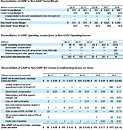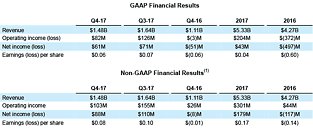- Joined
- Oct 9, 2007
- Messages
- 47,343 (7.51/day)
- Location
- Hyderabad, India
| System Name | RBMK-1000 |
|---|---|
| Processor | AMD Ryzen 7 5700G |
| Motherboard | ASUS ROG Strix B450-E Gaming |
| Cooling | DeepCool Gammax L240 V2 |
| Memory | 2x 8GB G.Skill Sniper X |
| Video Card(s) | Palit GeForce RTX 2080 SUPER GameRock |
| Storage | Western Digital Black NVMe 512GB |
| Display(s) | BenQ 1440p 60 Hz 27-inch |
| Case | Corsair Carbide 100R |
| Audio Device(s) | ASUS SupremeFX S1220A |
| Power Supply | Cooler Master MWE Gold 650W |
| Mouse | ASUS ROG Strix Impact |
| Keyboard | Gamdias Hermes E2 |
| Software | Windows 11 Pro |
AMD (NASDAQ:AMD) today announced revenue for the fourth quarter of 2017 of $1.48 billion, operating income of $82 million and net income of $61 million or diluted earnings per share of $0.06. Non-GAAP operating income was $103 million, non-GAAP net income was $88 million and non-GAAP diluted earnings per share was $0.08. For fiscal 2017, the Company reported revenue of $5.33 billion, operating income of $204 million and net income of $43 million or diluted earnings per share of $0.04. Non-GAAP operating income was $301 million, non-GAAP net income was $179 million and non-GAAP diluted earnings per share was $0.17.
"2017 marked a key inflection point for AMD as we re-shaped our product portfolio, delivered 25 percent annual revenue growth, expanded gross margin and achieved full-year profitability," said Dr. Lisa Su, AMD president and CEO. "We are even more excited about 2018 as we launch our next wave of high-performance products and continue to position AMD as one of the premier long-term growth companies in the technology industry."


Q4 2017 Results
AMD's outlook statements are based on current expectations. The following statements are forward-looking, and actual results could differ materially depending on market conditions and the factors set forth under "Cautionary Statement" below.
For Q1 2018, AMD expects revenue to be approximately $1.55 billion, plus or minus $50 million, an increase of 32 percent year-over-year, primarily driven by the strength of the ramp of new Ryzen, GPU and EPYC products.
Guidance for Q1 2018 and the year-over-year comparison are under the new revenue recognition accounting standard (ASC 606). AMD is adopting the new revenue recognition standard by applying the "full retrospective" method. For comparative purposes under the new standard, Q1 2017 restated revenue was $1.18 billion and Q4 2017 restated revenue was $1.34 billion.
For fiscal 2018, AMD expects the impact of the new standard on revenue to be immaterial.
View at TechPowerUp Main Site
"2017 marked a key inflection point for AMD as we re-shaped our product portfolio, delivered 25 percent annual revenue growth, expanded gross margin and achieved full-year profitability," said Dr. Lisa Su, AMD president and CEO. "We are even more excited about 2018 as we launch our next wave of high-performance products and continue to position AMD as one of the premier long-term growth companies in the technology industry."


Q4 2017 Results
- Revenue of $1.48 billion was up 34 percent year-over-year, primarily driven by strong sales of Radeon graphics and Ryzen processors. Revenue was down 10 percent sequentially, primarily driven by seasonally lower sales of semi-custom SoCs.
- Gross margin was 35 percent, up 3 percentage points year-over-year and flat sequentially.
- On a GAAP basis, operating income was $82 million compared to an operating loss of $3 million a year ago and operating income of $126 million in the prior quarter. The year-over-year increase was primarily due to higher revenue from the Computing and Graphics segment, while the sequential decrease was primarily due to seasonally lower Enterprise, Embedded and Semi-Custom segment revenue. Net income was $61 million compared to a net loss of $51 million a year ago and net income of $71 million in the prior quarter. Diluted earnings per share was $0.06 compared to a loss per share of $0.06 a year ago and diluted earnings per share of $0.07 in the prior quarter.
- On a non-GAAP basis, operating income was $103 million compared to operating income of $26 million a year ago and $155 million in the prior quarter. The year-over-year improvement was primarily due to higher revenue from the Computing and Graphics segment, while the sequential decrease was primarily due to seasonally lower Enterprise, Embedded and Semi-Custom segment revenue. Net income was $88 million compared to net loss of $8 million a year ago and net income of $110 million in the prior quarter. Diluted earnings per share was $0.08 compared to a loss per share of $0.01 a year ago and diluted earnings per share of $0.10 in the prior quarter.
- Cash and cash equivalents were $1.18 billion at the end of the quarter, up $306 million from the end of the prior quarter.
- Revenue of $5.33 billion, up 25 percent on an annual basis, was driven by an increase in the Computing and Graphics segment.
- On a GAAP basis, gross margin was 34 percent, up 11 percentage points from the prior year primarily due to the absence of a $340 million charge (WSA charge) recorded in 2016 associated with an amendment to our wafer supply agreement with GLOBALFOUNDRIES. Operating income was $204 million compared to an operating loss of $372 million in the prior year. The operating income improvement was primarily due to higher revenue and gross margin expansion in 2017, and the absence of the WSA charge recorded in 2016, partially offset by higher operating expenses. Net income was $43 million compared to a net loss of $497 million in the prior year. Diluted earnings per share was $0.04 compared to a loss per share of $0.60 in 2016.
- On a non-GAAP(1) basis, gross margin was 34 percent, up 3 percentage points year-over-year primarily due to improved revenue mix from new products. Operating income was $301 million compared to an operating income of $44 million in the prior year. Operating income improvement was primarily related to higher revenue and gross margin expansion, partially offset by higher operating expenses. Net income was $179 million compared to a net loss of $117 million in the prior year. Diluted earnings per share was $0.17 compared to a loss per share of $0.14 in 2016.
- Cash and cash equivalents were $1.18 billion at the end of the year, down from $1.26 billion at the end of 2016.
- Computing and Graphics segment revenue was $958 million, up 60 percent year-over-year and 17 percent sequentially. The year-over-year and sequential increases were primarily driven by strong sales of Radeon graphics and Ryzen desktop processors.
- Operating income was $85 million, compared to an operating loss of $21 million in Q4 2016 and operating income of $70 million in Q3 2017. The year-over-year and sequential improvements were primarily driven by higher revenue.
- Client average selling price (ASP) was up year-over-year driven by higher Ryzen desktop processors ASP. Client ASP was flat sequentially.
- GPU ASP increased year-over-year and sequentially due to higher desktop and professional graphics ASP.
- Enterprise, Embedded and Semi-Custom segment revenue was $522 million, up 3 percent year-over-year driven by server revenue. Sequentially, revenue decreased 37 percent driven by seasonally lower semi-custom SoC revenue.
- Operating income was $19 million compared to $47 million in Q4 2016 and $84 million in Q3 2017. The year-over-year decrease was primarily due to the absence of a $31 million licensing gain in Q4 2016 and an increase in R&D expenses, partially offset by the benefit from a richer product mix. The sequential decrease was primarily due to seasonally lower semi-custom SoC revenue.
- All Other operating loss was $22 million compared with operating losses of $29 million in Q4 2016 and $28 million in Q3 2017. The year-over-year and sequential improvement was primarily related to lower stock-based compensation charges in Q4
- AMD expanded its presence in the datacenter with new AMD EPYC processor-powered solutions and deployments:
- Microsoft Azure became the first global cloud provider to deploy AMD EPYC processors in its datacenters for its latest L-Series of Virtual Machines.
- Baidu deployed AMD EPYC single-socket platforms to power its AI, big data, and cloud computing datacenters.
- New high-performance platforms powered by AMD EPYC CPUs are now available from ecosystem partners including ASUS, GIGABYTE Technology, and Supermicro.
- The AMD EPYC processor-powered HPE ProLiant DL385 Gen10 server started shipping in volume in December 2017, which launched with record-setting SPEC CPU performance and features leadership cost per virtual machine configurations.
- EPYC CPUs were recognized as the Linley Group Analysts' Choice Awards "Best Server Processor" and in the "Top 5 Products or Technologies to Watch" category of both the HPCWire Readers' Choice and Editors' Choice Awards.
- AMD continued its commitment to bring innovation and competition to every segment of the PC market with the launch of its Ryzen Mobile Processors with Radeon Vega graphics, including the AMD Ryzen 7 2700U processor - the world's fastest processor for ultrathin notebooks.
- Combining the power of the "Zen" CPU and "Vega" GPU architectures, Ryzen mobile processors deliver up to 3x the CPU performance, up to 2.3x the GPU performance, and up to 58 percent less power consumption compared to the previous generation AMD notebook processors.
- Ryzen mobile-based notebooks are currently available from Acer, HP, and Lenovo, with more systems expected from Dell and other OEMs in Q1 2018.
- AMD and Qualcomm announced a collaboration to bring smooth and fast PC connectivity based on Qualcomm Snapdragon LTE modem solutions to high-performance AMD Ryzen mobile processors designed for consumer and enterprise notebooks.
- At CES 2018, AMD announced details for upcoming computing and graphics products including its first 7nm product, a Radeon "Vega" GPU specifically built for machine learning applications, as well as next-generation Ryzen CPUs and desktop Ryzen APUs.
- Momentum around AMD's next-generation "Vega" graphics portfolio continues to build:
- Apple launched its most powerful Mac ever, the iMac Pro featuring AMD Radeon Pro Vega graphics.
- AMD designed a semi-custom GPU that will be integrated into the 8th Gen Intel Core processor with Radeon RX Vega M Graphics.
- AMD announced the expansion of the "Vega" family with the Radeon Vega Mobile GPU for ultrathin notebooks.
- AMD released a major update to its advanced GPU software suite for Radeon graphics, the Radeon Software Adrenalin Edition.
- AMD announced the appointment of Mark Durcan to its board of directors.
- AMD expanded its leadership team with the appointment of graphics industry leaders Mike Rayfield as senior vice president and general manager of AMD Radeon Technologies Group (RTG) and David Wang as senior vice president of engineering for RTG. Rayfield will be responsible for all aspects of strategy and business management for AMD's consumer graphics, professional graphics, and semi-custom products. Wang will be responsible for all aspects of graphics engineering, including the technical strategy, architecture, hardware, and software for AMD graphics products and technologies.
AMD's outlook statements are based on current expectations. The following statements are forward-looking, and actual results could differ materially depending on market conditions and the factors set forth under "Cautionary Statement" below.
For Q1 2018, AMD expects revenue to be approximately $1.55 billion, plus or minus $50 million, an increase of 32 percent year-over-year, primarily driven by the strength of the ramp of new Ryzen, GPU and EPYC products.
Guidance for Q1 2018 and the year-over-year comparison are under the new revenue recognition accounting standard (ASC 606). AMD is adopting the new revenue recognition standard by applying the "full retrospective" method. For comparative purposes under the new standard, Q1 2017 restated revenue was $1.18 billion and Q4 2017 restated revenue was $1.34 billion.
For fiscal 2018, AMD expects the impact of the new standard on revenue to be immaterial.
View at TechPowerUp Main Site





